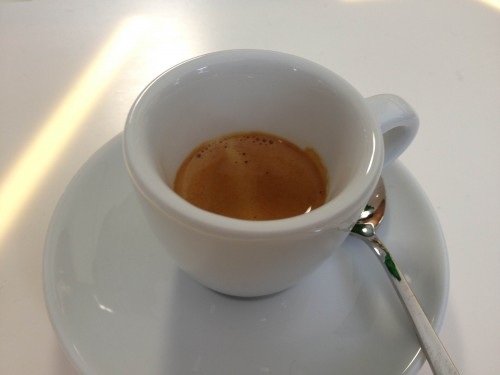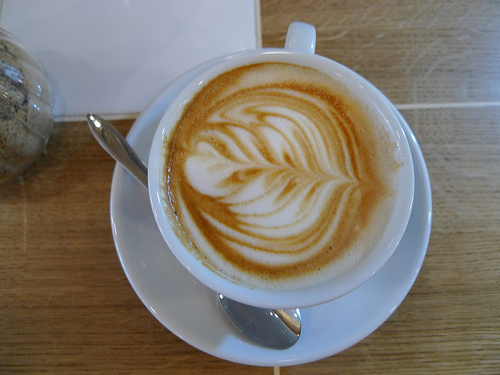It can be a struggle to decipher the coffee menu before you’ve actually had your coffee. We get it. Want to understand just what exactly you are ordering at your neighborhood café? Or fancy specialty coffee shop?

What You’ll Find at Every Corner Café:
Many places won’t even bring you a coffee menu because there is so little variation among these options:
- Café/Café Noir/Espresso/Express: A shot of espresso, often very dark and bitter
- Café Allongé: Espresso diluted with water
- Double/Double express: A double shot of espresso
- Filtré: Filtered coffee, also known as café américain. It will not be refilled, except if you go to Sugarplum Cake Shop.
- Noisette: An espresso with a spot of cream. It derives its name from the French word for hazelnut because of its color.
- Café crème/Cappuccino/Café Latte: Milky coffee, plain and simple. Your average café will rarely differentiate between any of the terms. These drinks will be espresso-based with a large proportion of milk, and the milk at your average place will be sterilized, shelf-stable, and slightly chalky. The price will be more expensive than an espresso. Cappuccinos typically cost slightly more than a café crème, will taste generally the same, and often come with cocoa powder or whipped cream on top. We’ve never seen a Parisian order one. It’s popular among visitors, and priced accordingly.
- Café Décaféiné or Un Déca: Decaffeinated espresso.
- Sur place: To be consumed on-site
- À Emporter: To go. Coffee to go is most likely not available at your average corner café. If you’re in a rush, you can shoot your espresso at the bar. Cafés are meant to be social spaces where one lingers. Most specialty coffee shops, however, will have to go cups available.
What You’ll Find at a Specialty Coffee Shop:
In addition to the options above, you might also find a few of these options:
- Flat White: An Aussie import. Similar to a cappuccino but with a thinner, more velvety foam that is incorporated into the drink instead of floating on top. Made with flat, non-aerated milk.
- Cortado: Espresso cut with a small amount of milk that has been added after the espresso.
- V60: A manual pour-over coffee dripper used to make filtered coffee.
- Chemex: A glass coffee dripper with a conical neck also used to make pour-over filtered coffee.
- Café Glacé: Iced coffee. Hard to come by.
- Extraction à Froid: Cold-brewed. Naturally sweeter and higher in caffeine. Not necessarily served iced.

Some Helpful Hints:
- Milky coffee is generally served at breakfast along with your meal. Otherwise, café (meaning espresso) is usually served after dessert as the finishing touch to your meal.
- Technically, café au lait is filtered coffee with milk, served in a large bowl at breakfast but almost exclusively in a home environment. Most cafés will understand what you mean however, and most people will simply swap in a café crème. Poilâne will serve you a giant bowl of café au lait if you sit down in their restaurant and order their whole déjeuner special.
- It’s not common to ask for half-caff, full-fat vs. low-fat milk, wet vs. dry coffee. Expect blank stares.
- Sugar is sucre and it’s often served in cubes. French coffee tends to be quite bitter so you may find you use more than you would normally. Sugar substitutes (Stevia, etc.) are rare.
- Iced coffee is hard to come by. You want to ask for café glacé. Most places will just pour coffee over ice, but we’ve seen some seriously mangled beverages involving coffee flavored syrup. Unless it’s actually on the menu (like at L’Arbre à Café, Coutume or Loustic) or you’re at Starbucks, it’s best to avoid.
- Milk: There is usually one kind of milk, and it comes from a box. It’s chalky, shelf stable and flavorless. Specialty shops like Coutume will use fresh milk. If you’re looking for milk at the grocery store, you should know that half & half as a concept does not exist. There is red top milk (whole), blue top milk (partially skimmed, 2%), and there is whole liquid cream.
- Specialty Milks: It’s quite rare to see soy milk, but it can be found at Starbucks and we’ve spotted it at Loustic and Tuck Shop (now closed) as well. Ask for soja (pronounce the j). Nutmilks? Good luck.
- Can you get milk on the side? You’re welcome to ask for un petit pichet à lait, but don’t be surprised if they look at you quizzically or are not able to accommodate your request. It’s not the culture, and most places don’t have the storage space for tiny pitchers.

I’ve been ordering coffee in Paris for 50 years usually successfully but your description made me an expert. Merci!
It’s so useful! I’m going to France next year as an exchange student. Hopefully I can still remember and order the right one
This was really useful, I am planning to visit a friend in France this summer so it is better to impress them by ordering my own coffee.
Very important information here for all Americans planning on drinking coffee in France (and other European countries). Coffee culture in America can be so one-sided, it’s great to learn more about the variety of European coffee before going abroad.
“There is red top milk (whole), blue top milk (partially skimmed, 2%), and there is whole liquid cream”
I drink the green top in my coffee which I assume is fat free. I tried the blue top one time and I thought it was some kind of heavy cream because it didn’t taste right in my coffee. Perhaps I will try again. Maybe I had a bad bottle. Does the whole liquid cream have a name? I actually need some to try my hand at making a mousse.
Yes, thank you for this post. I love everything about eating in Paris except for the coffee. I have drank coffee (with milk if the coffee is strong or bitter) with all sweets since I was 12-years-old. After a year in France drinking coffee without milk is one of the things that I simply cannot stand. It is a long trip for me now, but I still return to La Crêperie du Clown because they have a big cup of cafe creme.
But this is the French way and I moved here for French culture not to change it to my culture. However, for all their snobbery about my desire for not bitter coffee, I notice that everyone drinking coffee at the Starbucks speak French.
Big fan of the noisette’s! Paris cafe culture is one of a kind, can’t wait to get back there soon. One of my favorite places in the world.
🙂
As my sister told me before my first trip to Paris: “Just say ‘cafe creme’ then shut up and drink it.”
Ordering the right coffe can be a source of difficulty for many tourists, in addition to the so parsian attitude of waiters. Great guide above!
So here’s one for the french. I like to understand whether a cafe is going to put one or two shots in my coffee. Most of the places I go will understand “deux shots or un shot”. But what should the true french be for one or two shots?
When in Paris, embarrassingly if it’s one of those days that I do want an American coffee, I just go to McDonalds. Nothing will be as good as an espresso. It’s usually on a cold rainy day when I am looking for warmth not flavour.
Can’t even express how many times I’ve mistakenly ordered “un café” only to be disappointed with a petit espresso. #Fail.
I’m so glad I found your site. I’ve been to Paris many times and have always wondered at the coffee attitude I received from some Parisian friends who maligned my American coffee and praised the French. Coffee in the Pacific Northwest where I live is fantastic. 😉 I usually tell them that they haven’t tasted ‘true’ “american” coffee.
I typically order a noisette or a creme but have lately found the creme to be well.. universally lackluster. Puzzling the mediocre (or different) coffee one finds here in Paris when the food is so stunning.
I’ve been trying coffee shops off your list of best coffee and have so far been either unimpressed–not in a bad way..just no better than I can get back in Portland–or underwhelmed by the prices (expensive). So Far telescope has been the best (over in noodle land near Rue St. Anne).
If you have other options or must trys I would love to hear them!
Also, what does one do if black coffee or espresso is not to one’s liking?
Ha ha. Spot on.
here here, come to paris from half way around the globe to taste the same.
As a french parisian, I sometimes read your notes on this site to have a different point of view on what I’m experiencing everyday.
I agree, I’ve never ordered a cappuccino in Paris, nor my friends. What happens in Italy stays in Italy I should say 🙂
So, best is to stick to the Parisian way in Paris to have a real experience, and order a “café”. I personally drink it black and bitter, but you are welcome to add sugar as many of us do !
And what’s not mentioned here, it is also very common to ask for a glass of water on the side “avec un verre d’eau s’il vous plait”.
Good luck
Thanks for deciphering the coffee culture for me! I never seem to get the type of coffee I think I am ordering and always wonder what exactly the different variations mean.
Now I think I will be a little more prepared to tackle the streets of Paris and confident to order the kind of coffee I am in the mood for!
“At Holybelly”
Interesting. I tried to go and the line out the door of pesky Yankees and Brits was like that for a hamburger at the Camion Qui Fume.
Best non-Parisian coffee in Paris? At Holybelly. 19 RUE LUCIEN SAMPAIX – PARIS 10TH. They learned from the best in Melbourne, Australia and have taken it to Paris. I can’t wait to visit it in 2 weeks!
Agreed! Italian cappucino is something else and definitely far better than what you get in your bog standard French café.
Not just that, but for me, any coffee with milk (or hot chocolate) in Paris is over-priced.
Stick to a café espresso… and if you have to have some milk in your drink – try a café noisette which is normally only 50 centimes more expensive.
ive just recently started following you and I cant thank you enough for these helpful posts! we go to paris from Australia in April next year and haven’t got much of an idea what’s what. as a tea with soy milk person should I just wait until I come back home fir that beverage?!
I would advise against ordering cappuccino in Paris. Perhaps in specialty coffee bars you get the real deal, but the average cafe serves an abomination – a little “useless brown water”, topped with a huge head of foam, finished off with some cocoa powder…twice the price of a cafe creme. Wait till you get back home and go to Starbucks – or Italy!